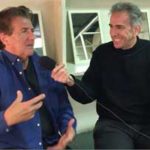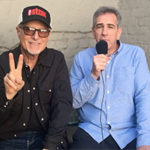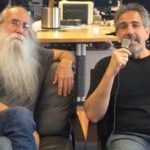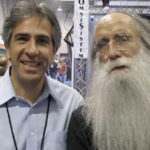L.A. session vet describes his new photo book and how he’s making the best of the pandemic
Exclusive interview with FBPO’s Jon Liebman
December 7, 2020
Leland Sklar is an indefatigable part of the L.A. studio scene. A veteran of countless recording sessions and world tours, he’s known far and wide for his stellar grooves, wry sense of humor and long, flowing, white beard. Sklar got his start playing alongside James Taylor in the 1960s, and since that time has become one of the most recorded bass players around, with his name appearing on more than 2,600 albums. Jackson Browne, Linda Ronstadt, Billy Cobham, and Phil Collins are just a few of the many recognizable names he’s collaborated with over the years. Beyond working with artists like that, Sklar has also contributed his musical skills to numerous TV shows and movies, including The Rockford Files, Hill Street Blues, Kindergarten Cop and Forrest Gump.
FBPO: It’s been almost three years since we did our last interview. It’s hard to believe it’s been that long.
Sklar: It’s been crazy.
FBPO: You were telling me about a Phil Collins tour, working with Judith Owen, playing with Danny Kortchmar, Waddy Wachtel, and Russ Kunkel, plus doing a Chinese project, a Peruvian project, an annual Library of Congress gig in Washington—and possibly going to the Musikmesse. Seems like it was a long time ago, doesn’t it?
Sklar: That’s what this year looked like before March, and then it suddenly disappeared like a fart in a hurricane.
FBPO: How much recording have you been able to do, session-wise, this year?
Sklar: Almost nothing. Almost everything shut down. Studios all shut down. Touring all shut down. I’ve been in the studio a couple of times and they were real limited projects, just a couple of us in the studio. Like the other day, I was doing a session with a guy who came down from the Bay Area, I think he’s in Oakland, and it was just piano and bass. He was in a room with the piano, and I was in an iso booth with my bass and that was it. A few sessions, but for the most part, it’s the first time in my career where I’ve actually recorded at home. I had never done that. Normally if somebody wanted me to do something, I would just say send me files, and I’d go over to a friend’s house because it was an excuse to go out and have lunch.
FBPO: It’s a whole new world.
Sklar: Yeah. I had a friend that contacted me about doing a recording. They wanted to do a cover of “Easy Lover.” And I said, “I’d love to do it, but I’m not set up for recording.” He had a friend at SSL, who ended up sending me a SSL2+ interface and I plugged into GarageBand, and Gussie sent me the file for the song. I dragged it in and contacted Steve Postell from our band, the Immediate Family, and he gave me a little tutorial on what to do. And I’ve just finished an album for a guy in Ireland and just did a track for a guy down in New Zealand. I’m set up now for home recording and I’ve been doing some. I’m not putting the word out that I’m totally available, but there’s a bunch of little projects coming in that I’m doing like that. But I’m primarily focused right now on my finger book.
FBPO: That was my next question! Tell me about your book. The title is Everybody Loves Me, right?
Sklar: Yeah. And it’s together with a guy. I met a guy through a mutual friend here in Pasadena, who has a company where he does fine art, and he does books. And we got to talking about it at dinner one night, and he thought this could be such a fun project. And next thing I know, we got involved together on it, and I sent him a little memory stick with 12,000 photographs of people giving me the finger and he honed it down to 6,000. And then thematically, we just laid the book out and stuff. There’s very little writing in the book. There’s a preface and an explanation of where the finger whole thing started with the first finger picture. And the rest of it is just humanity.
FBPO: Are the pictures mostly of well-known people?
Sklar: There’s a lot of famous people, but there’s a lot of not famous people in it too. And people have asked me, they said, “You have a big section with celebrities?” And I said, No, because everybody’s a celebrity as far as I’m concerned. It’s your voyage of discovery to be looking at a page full of all kinds of funny characters, and in the middle of it could be Debbie Gibson and Jay Leno.
FBPO: It sounds like you’re enjoying this project.
Sklar: It’s a lot of fun, but right now my stress is beginning to set in big time because of my initial launch. I’ve sold a little over 1,000 books on the initial launch. The books should arrive within a week, and then I’m doing it all myself. I’m printing all the labels, I’m packaging, I’m signing, delivering to the Post Office, and I’ve got 10,000 books coming. I’ve got a storage facility that I’m going to be loading them all into. I’m going to be sitting there with a pallet jack and all this. And amongst all that, then I’m also doing my fine art that I did all through my life. It’s available on there and I’m starting to sell that. And I’m doing T-shirts and all this shit. And today I have my twice a month livestream from my Clubhouse. I’ve found a way to be busier during this period than I would have been had I been working.
FBPO: Can you give us a few more names of some of the better known people whose pictures are in the book?
Sklar: Yeah, I mean there’s James Taylor, Phil Collins, Jackson Browne, Charlie Watts, Jeff Beck. Let me see… Jeremy Irons, Laurence Fishburne…
FBPO: Somebody told me you had Yo-Yo Ma.
Sklar: Oh yeah, I’ve got Yo-Yo.
FBPO: I heard you’ve got some nuns too!
Sklar: I have a nun. I would have had two if the other one hadn’t had such bad arthritis and couldn’t make a finger. There’s a little of everybody in here. And the thing I enjoy the most about it, from an observer standpoint, is that there’s a finite amount of ways of giving the finger. Like when Jack Black did it, he went, “You want balls, no balls?” kind of thing. But the faces are infinite. And the real fun to me is just to look at people, how they responded when they were empowered to give you the finger. And it goes from the most coy and shy to the most aggressive, and so the faces are really fun. I think at this time in history, we’re hurting and we just need some fun stuff just every day. And I think if somebody had this book and it was sitting on their coffee table or sitting out somewhere and somebody came over and looked at it and said, “What’s that?” And then started looking through it, they would become mesmerized by it.
FBPO: I have a picture of you and me doing it to each other at a NAMM show once. I was a little reluctant at first, but you got me to lighten up and just do it.
Sklar: Out of the 12,000 pictures, I probably had about a dozen people refuse. Most people, once you really say, “Come on,” then they just do it. But that’s where you get the responses, where you get everything from the absolute coyest picture to the most in-your-face. I always tell people, “Look, if you’re driving on the freeway and there’s a bunch of guys in a car next to you screaming out the window giving you the finger, that’s not the good finger you want.” But I said, “It’s just a finger. It’s not a big deal.” And most people got it. My parents are in it. I’ve got a great shot of them.
FBPO: They must be so proud of you!
Sklar: Oh, they loved it. My mom gave me the finger all the time after that. But they’re on a page and the opposite page is Willie Nelson, Merle Haggard and Kris Kristofferson together giving me the finger. I got Gwyneth Paltrow, Jeremy Pivens and Billy Bob Thornton. Bonnie Raitt’s in it, Paul Williams. There’s hundreds of celebrities in it.
FBPO: When you started this collection, did you have a book in mind, or did you do it just for fun, for schtick?
Sklar: The story that I tell in the book is when I was out with Phil Collins in 2004, they hired me a bass tech for the tour. I had never met him before, but they were putting the crew together. They got this guy, Steve Winstead, his nickname was “Chinner.” And he came into the tour ready to kick some butt. He was a great tech, and I think he works with Mike Campbell now. He came to me and said, “What do you need? What do you need?” And I said, “Nothing. I always do my own gear.” We had this running joke through the whole tour because he ended up really not having much to do with me, where he came in ready to put new strings on 15 basses every day and all this crap like he was used to doing. But when the tour was drawing to a close, there was serious word that Phil was going to retire at that point. He had to go back to New York and do Tarzan on Broadway and all this, and he was just fed up. I thought, I may never see a lot of these people again and a lot of the crew were from Europe and different places in the UK. So I thought I’m just going to take a picture of everybody and make a little folder for myself just to put away as a memory folder for the tour. And the first guy I walk up to is, I see Chinner sitting there working on his laptop and I go, “Hey, Chinner. Give me a smile.” And he’s typing away and he just goes (makes the “finger” gesture). And I look at the picture afterwards and I went, “That’s actually pretty good.” I went and I got everybody on the tour from Phil to the truck drivers, caterers, crew, and I ended up with about 120 photographs. And tucked it away in my computer. Just had Phil Tour, 2004, and that was it. And then when I went out with Toto a couple of years later, I thought, maybe I’ll do a similar thing with those guys. And I got them and it got up to about 300 pictures and started to take on an energy.
FBPO: That’s when you knew you were on to something.
Sklar: Then, the next thing, I would go to the NAMM Show. And I would just start going up to guys, “Hey, come on, flip me off.” And they’d go, “What’re you talking about?” I’d go, “Come on, man, flip me off.” I think I left the first day at NAMM with about 500 pictures. And it just took on a life of its own. I would be on an airplane, I could get the whole cabin to flip me off. I’d go up into the cockpit and get the pilot and co-pilot to flip me off. And it just kept going and it got to the point where people had an expectation that they were going to give me the finger. I’d go back to the trade shows or something and people would come running up to me now and give me the finger, unsolicited. I have so many pictures now. It’s probably somewhere close to about 15,000 photographs.
FBPO: You could do a volume two.
Sklar: Oh, easily, easily. Whether I want to or not, I don’t know. I’ll see how volume one goes.
FBPO: Do you have an official release date for the book?
Sklar: It’s available now on my website and I’m doing pre-order. But the books, they’re printed in China, outside of Hong Kong, and they’ve been shipped. I think they’ve arrived and we’re waiting for them to clear customs. Then they’re going to be delivered to the warehouse here in Pasadena that I’ve rented, and then I’m going to start filling orders. People can buy the book right now, and I’m trying to have them out so that people have them by Christmas. They told me at the Post Office that if I can get them in by the 11th of December, they’ll make Christmas for the domestic ones. The issue I’m having is Europe and overseas because the book is more to ship than it costs.
FBPO: Have you thought of doing a digital version?
Sklar: Well, at this point I could do that, but right now I want to sell what I committed to in hard copy. When the time comes, if I can do it again, then I could maybe talk to a distributor in Europe and just send them, because we have PDF for the whole book. At this point, I’m slightly overwhelmed with it all. I’ve gone from having a year where I was going to play bass all over the world and have fun, to having to become an entrepreneur and figure out ways of dealing with it. But I’m not the kind of person that’s going to sit on my ass and do nothing. And I’m trying to do things where I feel viable and I maintain interest in the business. It’s like with our band, the Immediate Family. We’re working our butts off with this thing. We’ve got a new video, our third video coming out. We’ve got another EP that’s going to be coming out. Our album will be coming out at the beginning of the year.
FBPO: Are you recording now, remotely?
Sklar: No, they were recorded before the pandemic. And the albums, we’ve been just waiting on it because Denny Tedesco is doing a documentary film about us.
FBPO: Didn’t he do The Wrecking Crew documentary?
Sklar: He did The Wrecking Crew. And so he’s doing this film. And they’re about three quarters the way through it, and everything ground to a bit of a halt because of this. It’s still moving forward but it’s moving forward on a slower basis. That won’t probably come out until the middle of next year, and we don’t know if we want the album to wait that long. We’re with a label called Quarto Valley Records out here in California, and I think we’re going to look at an earlier part of the year to release the album. And then we’ve done two live streams and we’ll probably do another live stream concert. That’s the band with “Kootch” (Danny Kortchmar) and Waddy (Wachtel) and (Russ) Kunkel and myself, and Steve Postell.
FBPO: With the live streams, are you actually in a room together?
Sklar: Yeah. We did one of them at The Coach House down here. And then Don Lombardi let us use the sound stage at DW Drums to do it and use his crew. We stayed pretty far apart and everybody was masked and temperatures and all that. And then just took the masks off to do the video and then right back on during the break. We’re being as cautious about everything as we can with it.
FBPO: It’s good how you’ve managed to make the most of this crazy situation.
Sklar: There’s no telling how long this is going to go on. There’s lots of talk with vaccines and stuff, but it’s probably going to be, before we can do anything remotely that with touring and stuff, will probably be at least the middle of next year, if not towards the end of next year, for people to be safe. Because this is going to be a big thing to deal with and you’re going to have a ton of people who think it’s still a hoax and anti-vaxxers who aren’t going to do anything. It’s going to be a very dangerous environment for a long time, I think. We just don’t know, so I’m going to focus every day on doing something positive for the community and for myself and wait it out.
FBPO: We’ll get the word out to our audience about the book and help spread the word. I’m happy to do that for you.
Sklar: I appreciate that so much. It’s always fun working with you, Jon. I always really enjoy it.
FBPO: Any updates about your gear and equipment? I see you’re holding a Dingwall bass.
Sklar: Not really. For me, I’m really settled into what I need. And so when I need a five string, I use my Dingwall. I was just getting ready to do my daily video. I’m doing a Bonnie Raitt song that I did with her. I use my Warwick signature Star Bass. My “Sklar” bass. I love that bass. It’s got such a beautiful tone. And it’s a beautiful chambered instrument and stuff. And then between those two and my “Frankenstein,” that’s pretty much the basses I use for almost everything. I’ve got a Star bass fretless. When I need fretless I’ve got that. And I’ve got a Hofner, if suddenly I need that kind of a sound. But those three basses basically do everything. And my Euphonic Audio amps are still what I’ve been using for 20 years now. And I still love those. And all my touring gear, everything is just sitting in my garage waiting for a tour. I keep everything at home.
FBPO: What is the Frankenstein bass exactly?
Sklar: The Frankenstein—and the reason I call it Frankenstein is because it was never a bass. It was parts that I assembled with John Carruthers. When John Carruthers used to run the repair department at Westwood Music for Fred Walecki, back in the ’70s. That was the watering hole for most of the players. Anytime you stopped in that music store, you’d see Ry Cooder and Jackson Browne and different guys playing instruments and checking stuff out. I happened onto a ’62 Precision neck, it was just the neck, and I ended up buying that and took it to John and we took a template. Because my original first professional bass, I had some really cheapo basses when I was learning, but my first real bass was a ’62 Jazz bass. And I’ve still got it. We took a template off that neck and then popped the frets out of the Precision neck and reshaped that neck into a Jazz neck. And during the course of doing that is when I discovered mandolin fret wire. Then I went out to Charvel, which was building instrument parts in San Dimas, and they had a big stack of older Precision bass bodies, all these replacement bodies. And I just took each one of those and hung them from a piece of wire and tapped them until one of them just resonated, and I said, “I’ll take this one.” And took it back to John and then we were putting the neck on that body. It was a Precision body but I still prefer Jazz, so what we did was I contacted Rob (Turner) at EMG and got a set of their very first Precision EMG pickups. We put the Precision pickups where Jazz pickups would have gone. We rerouted the body for those.
FBPO: But the shapes of those pickups are different.
Sklar: Well, I reversed the position of the pickups. Because when you’re looking at a Precision pickup, it’s a split pickup. You’ve got a pickup for the G and the D and a pickup for the A and the E. Well, I thought by the nature of the G and D, they’re going to read better than the A and the E anyhow, so why not put that half of the pickup closer to the bridge on the A and the E. We flipped the pickups and reversed their position. And then between those pickups was still the cavity where the original Precision pickup would have gone, so we used that for the two nine-volt batteries so I didn’t have to cut another hole.
FBPO: That’s smart.
Sklar: And just put a little cover plate over it. And then I’ve got a Badass II bridge that we put on that. Did a brass nut on it. And then I’ve got the first Hipshot detuner that they designed and contacted me and Dave (Borisoff) said, “Want to check this out?” And I ended up doing their first ads for them for the Hipshot. That’s why it’s Frankenstein.
FBPO: Is that your main go-to bass?
Sklar: That’s the bass I’ve used on almost every record since ’73 when we built it.
FBPO: What advice can you impart to somebody who wants to learn to play bass?
Sklar: I think a critical thing would be: Be patient. As you’re learning, don’t get frustrated and want to be Jaco overnight. Some people have that kind of personality where they want it to be right immediately. If I guy just goes, “I’m really a fan of country music, I love country music,” just find some songs, a couple of songs that maybe aren’t difficult in the beginning and listen to them and feel around on the bass and figure out where they are on it and play it over and over until you’re confident. Because I think once you build confidence, then you can move forward. If you’re intimidated every time you pick the instrument up and don’t think you’re going to get it, then you’re never going to get it. But you just do it. It’s like: Do it by rote. It’s the way when I toured with Toto. I had five days to learn their show before our first gig. And all I did was immersed myself in their music and played it over and over and over and over until I was comfortable with it and I knew what I was doing.
FBPO: You made me think of something else, especially when you mentioned a country song. People often neglect the importance of “1-5, 1-5,” but it’s just as important as anything else. The attack, the release, the tone.
Sklar: We’re exactly on the same page, because when I would do a masterclass or anything like that, I would say, “Do you know how hard it is to play a whole note?” If you’re sitting there just shredding, you can get away with murder. If you’re giving one note a bar, how are you going to play that? Where are you going to place it? How are you going to release off of it? I could do a five-minute dissertation on a note. The important thing in my career has always been the song. The needs of the song. If I’m doing “Stratus” or something with Billy Cobham, that’s one thing, but if I’m doing “For My Broken Heart” with Reba McEntire and I’m just supporting the whole notes, those are as important as the bass lick in “Stratus.” It’s the song and you honor the song. Nothing’s beneath you. It’s an interesting little adventure. But for people starting now, be patient, take your time, and really just give yourself time to learn what you’re doing. And you’ll get there, to whatever extent you want to get there.
FBPO: Thanks for all the great info, and good luck with your new book.
Sklar: The book is really, really fun. And that’s the main thing. When you start looking at it and you start looking at the responses of people’s faces in it, it’s a real fun adventure.
FBPO: I’m glad you’re having fun.
Sklar: Well, you got to. We’re here for such a short time, why piss it away.
Leland’s new book, Everybody Loves Me, is available here:
See Jon’s blog, with key takeaways from this interview here.








